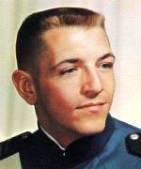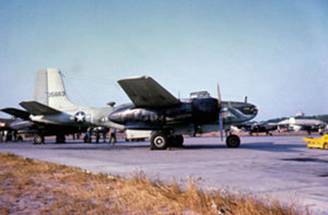
Andi Biancur
War Story
On 1 April, 1961, following the guidance of President Kennedy, the Air Force established the 4400th Combat Crew Training Squadron (CCTS)--code named Jungle Jim--to counter the increasing terrorist attacks by communist guerrillas in South Vietnam, supported by North Vietnam. A detachment (Det.-2A) of the 4400th was subsequently established at Bien Hoa AB in South Vietnam. Using the code name, Farmgate, and beneath its training cover, its mission was to stop communist guerrilla forces in the south. Farmgate was a highly classified mission committed to providing close air support to Vietnamese ground forces and to attack the Viet Cong.
In January of 1963, I was assigned to the 4400th CCTS for training in the Douglas B-26 Invader. Following that training, I, along with my navigator, 2/Lt Wells T. Jackson, arrived at Det-2A on 1 May 1963. When we became competent in performing the various required combat tactics, we were further assigned to a Deployed Air Strike Team (DAST). The DAST generally consisted of two B-26s paired to operate from various airfields in South Vietnam for temporary periods in support of ongoing operations. It was while assigned to a DAST, that Wells and I found ourselves at Danang AB in August 1963

On 16th of August, 1963, I was fragged on an interdiction mission to a mountain valley target in I Corps. For whatever reason, Wells was replaced by 1/Lt Woody Halsey as a crew member for that mission. We also carried a Vietnamese observer (name unknown). We departed from Danang AB in B-26 # 44-35822 shortly after 1300 hours and proceeded to our target in Quang Ngai Province.
The second B-26, # 44-34681, flown by Captain John McClean (pilot) and Lieutenant Arthur 'Skip' Bedal (navigator) also drew a target in the mountains southwest of Danang and departed at approximately the same time. (I cannot recall if we went as a two-ship formation or were later directed to the same target.)
Regardless, both of us wound up working the target as a two-ship formation, under the direction of a Vietnamese Forward Air Controller (FAC), flying an O-1 aircraft. We had each made a pass or two on the target located in a north-south valley in a fairly rugged narrow mountainous area. I had pulled off the target and was up on a left downwind (the perch) heading northeast when McClean began his run to the southwest. Shortly after he began his run, the Vietnamese FAC yelled over the air the words: "His wing come off!". I glanced to my left and caught sight of the wing section flipping through the air. I immediately caught sight of the remainder of the aircraft tumbling out-of-control and heading for the ground. I yelled for them to get out, but, of course, it was impossible because of the adverse Gs and lack of time. The two large sections of aircraft impacted the jungle some distance from one another. I immediately broke off the attack and called Paris Control (the tactical control agency ) to report the incident. We remained in the area flying air cover over the site until we were relieved by--what I recall to be, two T-28s).
It is my opinion that the wing separated from the aircraft as a result of structural failure and not enemy action, for the following reasons: 1. McClean was positioned early on his ordnance delivery run. At that point, the only force active on the aircraft should have been increased airspeed. He was well above the altitude where he would normally have initiated a pull out causing increased G forces. 2. There was no visible explosion or fire associated with the aircraft, only the two sections trailing fuel vapor. 3. I believe that if there had been hostile ground fire, the FAC would have yelled some other words. 4. The entire time we remained over the area, even on our low passes initiated to determine if there were survivors, we never experienced hostile fire. 5. Later the photos we were shown, taken by photo reconnaissance aircraft and ground recovery assets, showed the wreckage pattern to be indicative of wing separation at altitude.